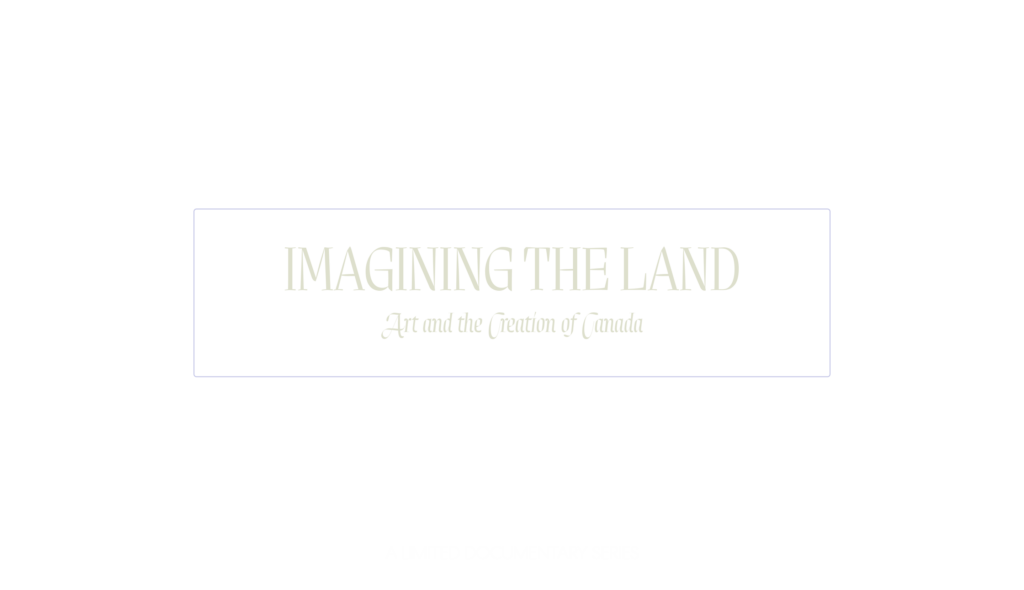

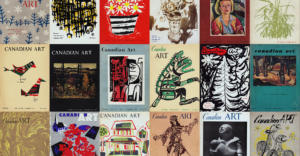
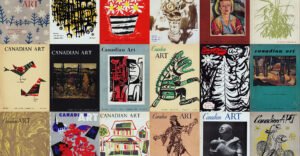
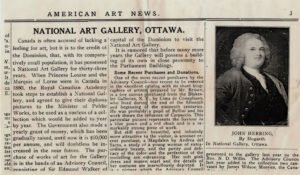
Read More
“Canada is often accused of lacking a feeling for art, but it is to the credit of the dominion, that, with its comparatively small population, it has possessed a National Art Gallery for thirty-three years” American Art News, May 1913.
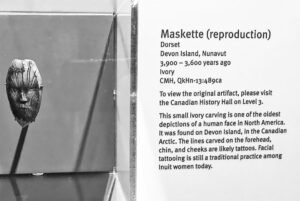
Read More
Reproduction of the Icebreaker Beach maskette, an original ivory carving discovered in 1986 on NE Devon Island, N.W.T. The original is a small, oval piece of walrus ivory measuring 54.2mm in length, 29.3mm in width and 8.2mm in thickness. It is the oldest known depiction of a human face in Canada. Collection of the Canadian Museum of History/Musée canadien de l’histoire.
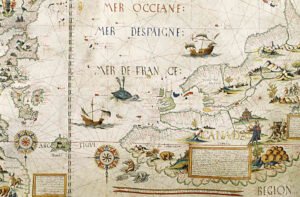
Read More
The Desceliers Mappemonde, 1543 was produced for the King of France, and celebrates the recent discoveries of Jacques Cartier on the north-east coast of America. The placement of Canada is flipped as the map was designed to be viewed on a table, with the information to the top of the map appearing upside-down. © Bibliothèque nationale de France.
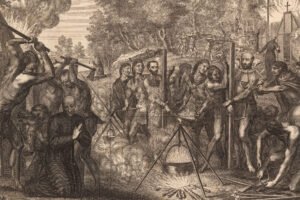
Read More
Grégoire Huret, (1606-1670) Preciosa mors quorundam patrum é Societ. Iesu in Nova Francia.
“The Death of some Jesuit Fathers in Nouvelle-France”. First published in Historiae Canadensis, sev Novae-Franciae Libri Decem, Ad Annum usque Christi, MDCLV François Du Creux 1664. BAnQ, collections patrimoniales © Bibliothèque et Archives nationales du Québec.

Read More
Ojibwe pictograph of a mishibizhiw part of the Agawa Bay pictograph trail, Lake Superior Provincial Park. The pictographs are painted on the rock with a mixture of powdered hematite and animal fats and were painted over a period of approximately 250 years, with the earliest ones thought to date from circa 1700.
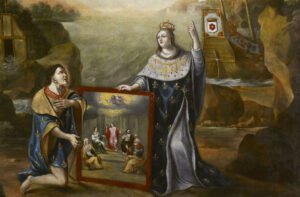
Read More
“France apportant la foi aux Hurons de la Nouvelle France”, attributed to a Récollet friar named Frere Luc, who executed a number of works during a fifteen month stay in the colony from April 1670 to July 1671. The painting is an allegorical depiction of the first conversion of the Hurons by Jesuit missionaries. © Ursuline Convent, Quebec City.
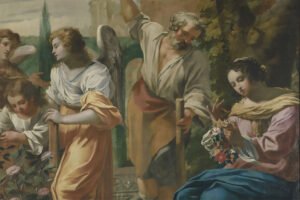
Read More
La Sainte Famille à Nazareth. Anon., from the studio of Simon Vouet in Paris, ca. 1600. This painting is one of 200 French paintings that were imported into Quebec City by the Abbé Desjardins in 1817 and 1820. They are the first Old Master paintings to arrive in Canada.
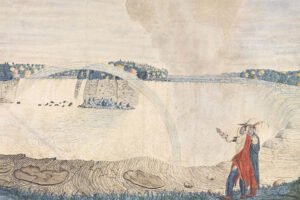
Read More
Thomas Davies (c. 1737–1812). An East View of the Great Cataract of Niagara, 1762. Painted on site in 1762 this topographical watercolour provides the very first accurate portrait of Niagara Falls. © National Army Museum, London UK.
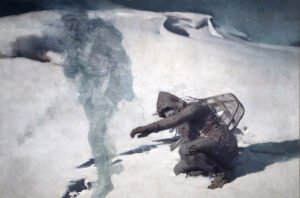
Read More
The Phantom Hunter by William Blair Bruce, 1888. Bruce was born in Hamilton, Ontario and moved to Paris at the age of 22, where he studied under Adolphe-William Bouguereau, the pre-eminent painter in the academic style of the late 19th century. The Phantom Hunter was Bruce’s first major success and was exhibited at the 1888 Paris Salon.
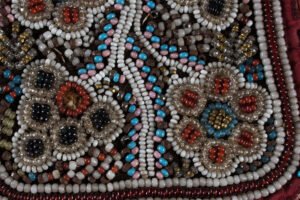
Read More
“Detail of Mi´kmaq belt. Collected 1868. Old collection label with following text: “Sash in beads Fredericton 1868” and on the other side “North Amerika 9”. Old paper label from Wallis & Wallis auction house, with auction and item number, auction September 1961. L. 134 cm, W. 8 cm. Provenance: Old Swedish collection, Wallis & Wallis auction 1961, British collection.

Read More
Richard Jack at work on his painting, The Second Battle of Ypres, the first work of art created for the official Canadian War Memorials Fund, established in 1916. Jack was one of 120 mostly British and Canadian artists employed by the art program, which eventually led to the creation of almost 1000 works of art during the period between 1916 and 1919. © George Metcalf Archival Collection
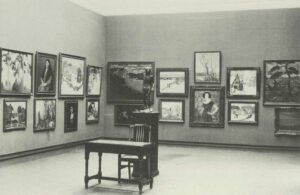
Read More
Group of Seven works at the 1924 British Empire Exhibition in Wembley. The showing met with success—the Tate Gallery purchased an A.Y. Jackson, and one critic noted that their works captured “the buoyant, eager, defiant spirit of the nation.”

Read More
David Milne, Store Fronts (New York), 1914-1915. Milne was born in 1882 to Scottish immigrant parents in Burgoyne, Ontario. After studying art via correspondence courses, he decided to move to New York in 1903 at the age of 21. He was the only Canadian artist exhibited in the epochal Armory Show of 1913. Although underappreciated in his lifetime, he is now widely regarded as one of Canada’s greatest artists.

Read More
Objects confiscated from the Kwakwaka’wakw people during the period of the Potlatch ban are displayed in the Anglican parish hall in Alert Bay under the orders of William Halliday, 1921. The stolen objects were inventoried, crated and sent to Ottawa, with many of them ending up in the collections of museums around the world. Halliday also illegally sold some items to a US collector while the pieces were still in Alert Bay.
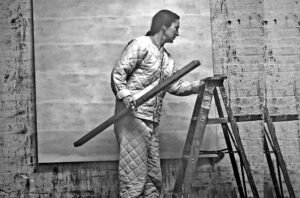
Read More
Agnes Martin (1912-2004) with level and ladder in her studio at Coenties Slip, Lower Manhattan, 1960. Martin was born in Macklin, Saskatchewan and moved to New York in 1957. She is widely seen as one of the most important painters of the latter part of the 20th century. Alexander Liberman Photography Archive, Getty Research Institute, Los Angeles. © J. Paul Getty Trust.
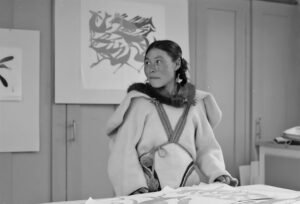
Read More
Kenojuak Ashevak (1927-2013) at the West Baffin Eskimo Co-op in Kinngait, Nunavut, 1961. Photograph by B. Korda. Originally published in National Film Board Photostories No. 308, April 1962. Original Caption: “Kenojuak’s work is sought after by international collectors, art museums.”
© Library and Archives Canada.

Read More
“The Girl Who Went Out in the Cold”, Vogue Magazine, November 1, 1964, Photographer John Cowan, Model Jill Kennington. Resolute Bay, Cornwallis Island, Qikiqtaaluk Region, Nunavut. Collection of Prints, Drawings & Paintings Collection, Victoria and Albert Museum, London. Accession number E.2052-2004. © Condé Nast.
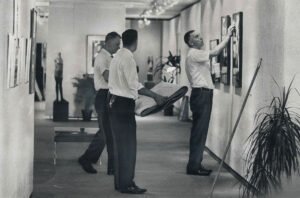
Read More
Toronto Police from the Morality Squad taking down drawings at the Dorothy Cameron Gallery during an exhibition on the theme of physical love in May 1965. Cameron was charged and convicted of exhibiting seven obscene drawings. The most prominent art dealer in Toronto at the time, Dorothy Cameron appealed her conviction all the way to the Supreme Court of Canada, but lost her case and closed her gallery in 1966.
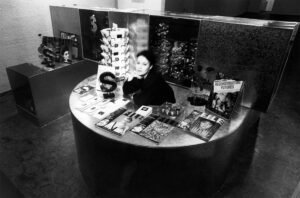
Read More
General Idea was a collective of three artists, Felix Partz, Jorge Zontal and AA Bronson. The “1984 Miss General Idea Pavillion” was the focus of their work for a decade starting in 1977. The Boutique from the 1984 Miss General Idea Pavillion was first presented at the Carmen Lamanna Gallery in Toronto in December 1980.
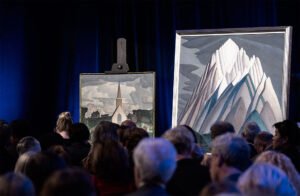
Read More
In November 2016, Lawren Harris’ Mountain Forms, from 1926, became the most expensive Canadian artwork ever sold, garnering $11.2M at auction. The seller was Imperial Oil Inc., who had acquired it in 1984 from Galerie Walter Klinkhoff in Montreal for an undisclosed amount, thought to be in the range of $350,000. The name of the purchaser was not revealed.